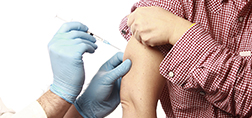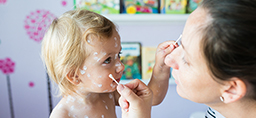
School is in full swing, and with it comes a plethora of colds passed back and forth among kids.
But parents who want to alleviate a sick child’s misery would do best to avoid over-the-counter cough and cold remedies.
Decongestants should not be given to children younger than 6 because there’s no evidence that they do any good, according to a new review published online in the BMJ.
Kids and meds: 7 tips for safe dosing
Lindsey Jelsma, PNP-PC, a pediatric nurse practitioner at Spectrum Health Helen DeVos Children’s Hospital, has a few tips and recommendations for parents and caregivers.
- Read the package. Before you give a child any medication—prescription or over-the-counter—be sure to read the label and any package inserts. Remember that many non-prescription medications are formulated for adults, so they may not be safe for kids.
- Know your child’s weight. The child’s weight is the biggest factor in safe dosing, Jelsma said. “Kids around the age of 12 normally start to fall within the safe range dosing for adults,” she said, but if your child is small for their age, be careful.
- Measure liquid medicines accurately. If the dose is 1 teaspoon, any old spoon won’t do! Be sure to use an accurate measuring utensil: a syringe, a medicine dropper or the plastic cup that came with the bottle. If you don’t have a proper measuring device, ask for one at your pharmacy.
- Write it down. Make a timeline of your child’s illness, keeping track of when you administer each medication.
- Be careful with medicines that have multiple components. Many over-the-counter cold and flu medicines contain multiple ingredients, such as acetaminophen plus a decongestant. Even if your child is big enough to take a cold medicine, don’t give Tylenol on top of it. This could amount to giving a double dose, which carries the risk of organ damage.
- Ask a professional. If you’re unsure of what medicine to choose, how much to give or whether two medications can be combined, call your pediatrician or primary care provider. Or ask a pharmacist.
- Don’t hesitate to call Poison Help. If you think you may have given your child too much medicine, or if a child has accidentally ingested something, call 1.800.222.1222.
These over-the-counter medications don’t effectively alleviate symptoms like a stuffy or runny nose, but do carry potentially dangerous side-effects for kids, said senior researcher Dr. An De Sutter. She is head of family medicine and primary health care at Ghent University in Belgium.
Certain decongestants “can have serious side-effects, such as hypertension, excitation and convulsions,” De Sutter said.
The new evidence review lends additional weight to a 2008 warning issued by the U.S. Food and Drug Administration that no cough and cold product should be given to children younger than 2, and they should be used only with caution in older kids.
The American Academy of Pediatrics also recommends against the use of OTC cough and cold remedies for children younger than 4, said Dr. Jeffrey Gerber, medical director of the Antimicrobial Stewardship Program at Children’s Hospital of Philadelphia.
“Generally speaking, at best in adults the risks and benefits are probably around equal. And in kids the risks outweigh the benefits,” Gerber said.
The common cold is usually caused by viruses, and symptoms usually clear in seven to 10 days, the study authors noted in background notes. Children get about six to eight colds a year, compared with two to four colds annually for adults.
Current evidence from clinical trials shows decongestants provide little to no relief for children, the researchers said.
The study authors concluded that decongestants or medicines containing antihistamines should not be given to children under 6, and used with caution in children aged 6 to 12.
The tradeoff simply isn’t worth it, Gerber said, even if the chances of a severe side-effect are minimal.
“You can have interactions that can make your heart race, for example,” he explained. “If you had some type of underlying condition you may or may not know about, you could exacerbate that and cause an arrhythmia. That doesn’t happen so often, but it is a possibility.”
The OTC remedies don’t work much better for adults, the study found. Using decongestants either alone or with antihistamines or pain relievers can have a small effect on blocked or runny noses, for up to three to seven days, the researchers said.
But adults run an increased risk of side-effects like insomnia, drowsiness, headache or stomach upset, the findings showed. Ironically, long-term use of decongestants can lead to chronic nasal congestion.
There’s also inadequate evidence supporting other commonly used OTC or home treatments, such as steam, heated air humidifiers, analgesics, vapor rub, echinacea or probiotics, the report said.
Saline nasal irrigation or drops are a parent’s safest way to relieve a child’s stuffy nose, according to the report, but these may not work.
Parents can use acetaminophen (children’s Tylenol) or ibuprofen (children’s Motrin) to reduce fever, aches and pains in children, and a cool-mist humidifier can help nasal passages shrink to allow for easier breathing, the FDA suggests. In addition, kids should drink plenty of fluids to remain hydrated.

 /a>
/a>
 /a>
/a>
 /a>
/a>